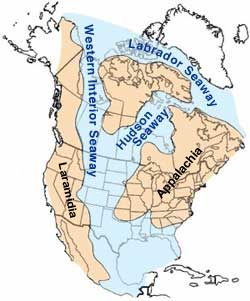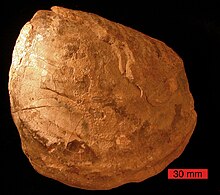Western Interior Seaway
The Western Interior Seaway , also Cretaceous Interior Seaway , was an extensive epicontinental shallow sea in the Middle and Late Cretaceous Period , which crossed the North American continent from north to south as a broad arm of the sea .
Historical geology
The Western Interior Seaway was formed when the Farallon Plate and the North American continental plate collided and the Rocky Mountains were formed in western North America . Since the sea level was high worldwide during the Cretaceous Period, water flowed from the north from the Arctic Ocean and from the south from the Gulf of Mexico into the central lowlands and formed a shallow sea that enlarged several times during the Cretaceous period ( transgression ) and then retreated again (regression ).
The earliest phase of the Seaway began shortly before the end of the Early Cretaceous Period, when a southern branch of the Arctic Ocean spread across western North America. It is called the Mowry Sea after a characteristic rock formation rich in oil shale . In the south stretched the Gulf of Mexico, at that time part of the Tethys Ocean , which connected with the Mowry Sea in the Middle Cretaceous and formed the complete Seaway.
At its greatest extent, the Interior Seaway stretched from the Rocky Mountains in the west to the Appalachians in the east and was approximately 1,000 kilometers wide. Its greatest depth was around 800 to 900 meters, which is small compared to other seas. The rivers of two large continental watersheds flowed into it from the east and west, and deposited fine-grained sediment ( silt ) in extensive river deltas along the flat coasts. There was little sediment formation on the eastern shores of the sea, but the western shore consisted of thick sediment packages that were eroded to the east during the Sevier orogeny . The course of the coast on the western shore was therefore highly variable, depending on changes in sea level and sediment input.
Widespread carbonate deposits suggest a warm, tropical climate in which mass deposits of lime-forming algae developed. Rudy Slingerland of Penn State University used a computer model to calculate that the current in the Western Interior Seaway was counterclockwise, with cooler water flowing south along the eastern coasts of what is now Wyoming and Colorado .
At the end of the Cretaceous period it came to the Laramide orogeny and deeper pool was sandstone and shale deposited. The Western Interior Seaway split and retreated south to the Gulf of Mexico. This shrinking, regressive phase of the Western Interior Seaway is called the Pierre Seaway .
During the early Paleocene , parts of the western Interior Seaway inundated the lower Mississippi River to what is now Memphis .
Life in the sea

Numerous fossil evidence document the past life in the Western Interior Seaway. Predatory reptiles lived in the sea , including the largest animals of the Cretaceous seas: mosasaurs , which were up to 18 meters long, as well as ichthyo- and plesiosaurs . There were also sharks , for example Squalicorax , and bony fish such as Pachyrhizodus , Enchodus and Xiphactinus . There were mollusks , including ammonites and the squid-like belemnites . Even single-celled plankton has been preserved in fossil form, including foraminifera , radiolarians and the coccolithophorales , an order of calcareous algae . After their death, the calcareous algae left behind tiny, disc-shaped limestone platelets, the coccoliths , which sank to the ground in masses and, in the course of geological time, created the mighty chalk deposits that gave the Cretaceous its name.
The Western Interior Seaway was also home to early birds , including the flightless Hesperornis and the tern-like Ichthyornis . Both had toothed beaks.
See also
literature
- Steven M. Stanley: Historical Geology. An introduction to the history of the earth and life. Spectrum textbook. 1st edition. Spektrum, Akad. Verlag, Heidelberg et al. 1994, ISBN 3-86025-009-4 .
Individual evidence
- ^ A b c d Steven M. Stanley: Earth System History. WH Freeman and Company, New York 1999, ISBN 0-7167-2882-6 , pp. 487-489.
- ↑ James S. Monroe, Reed Wicander: The Changing Earth: Exploring Geology and Evolution. 2nd Edition. West Publishing Company, Belmont 1997, ISBN 0-314-09577-2 , p. 610.
- ^ Oceans of Kansas Paleontology. Mike Everhart, accessed February 6, 2007 .

